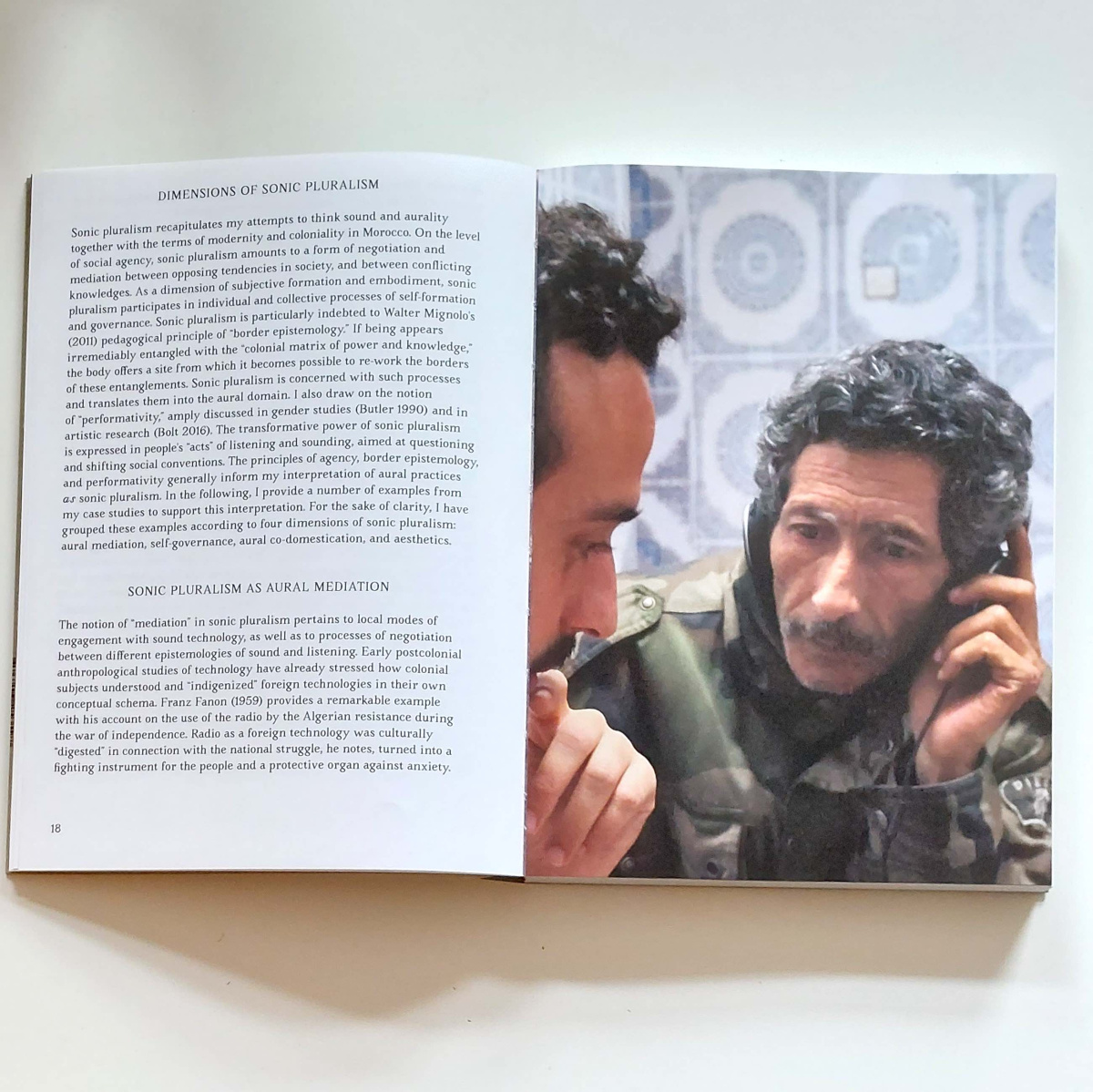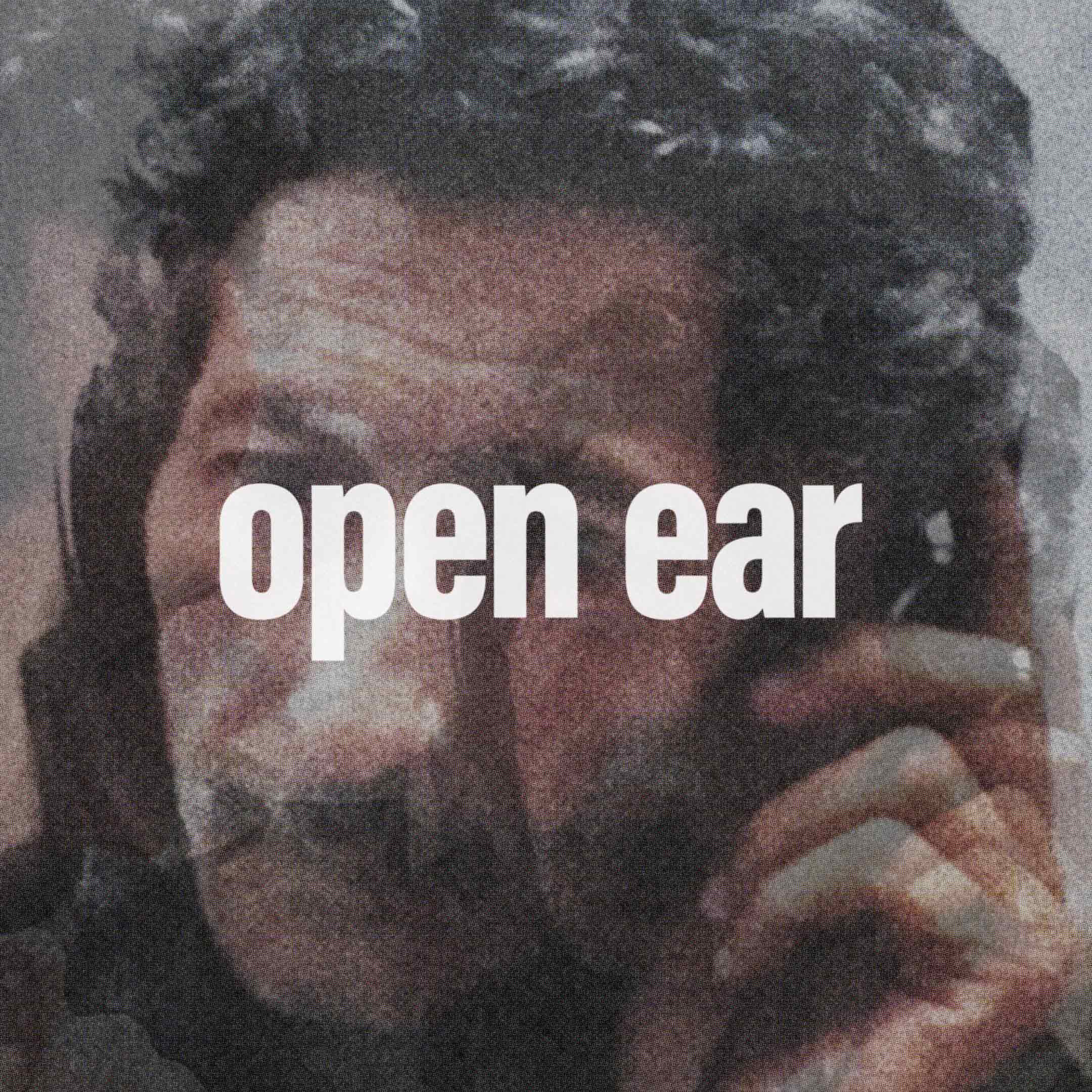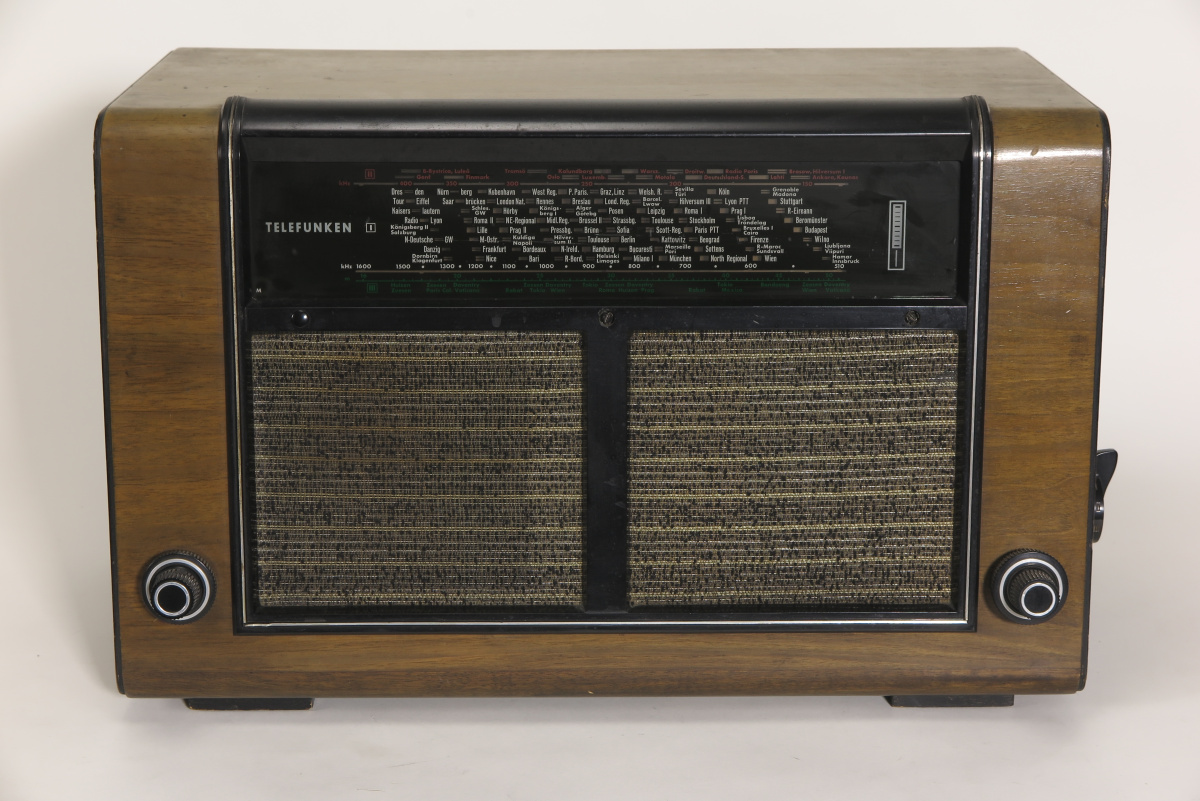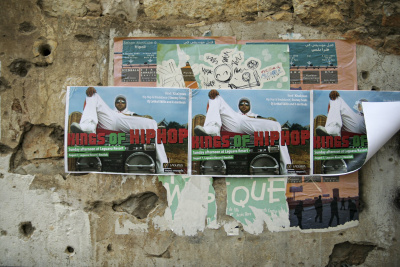
Listening Through Others
For more than a decade, Gilles Aubry has been researching the sounds of Morocco, with and through other artists, musicians, and creative practitioners. Sawt, Bodies, Species: Sonic Pluralism in Morocco (from here on SBS), presents this journey of artistic research subsequently framed by the theoretical impression of sonic pluralism, which the artist evokes across the book’s six chapters. In my response to Aubry’s book, I highlight his aim, approach, and articulation of what it means to listen through another set of ears.
The conceptual framework of sonic pluralism was formed out of his continued research into Morocco’s sonic environment. Aubry formulates sonic pluralism as the intersection of varying fields and processes «where potentially oppressive knowledge is acquired in order to be critically re-purposed for different ends» (Aubry 2023, 43). It also refers to the «constitutive plurality of the postcolonial aural field and to people’s ability to act upon their own listening in order to find new meanings in aural experience» (11). The book takes into account postcolonial conditions, local knowledge, and intersecting positionalities to foreground diverse perspectives that co-exist and come to form new meaning. In the author’s words,
On a sound epistemological level, sonic pluralism in my study pertains to examples of direct engagement with recording technology and colonial music archives. Local initiatives open up new perspectives on colonial sound epistemology, raising questions about the «erasure effects» of ethnographic recording, about racist ideas and misrepresentation of «native cultures». (12)
Aubry wrestles with the relationship between sound, modernity, and coloniality in Morocco, through research nodes that offer a spectrum of sonic affordances of regions in Morocco. SBS picks up on other scholarly contributions that question coloniality, modernity, and aurality, such as Audible Empire: Music, Global Politics, Critique. Edited by Ronald Radano and the late Tejumola Olaniyan (2016), this collection of essays expands upon the relationship between transnational movements, sound recordings, and imperial structures shaped auditory formations globally. Audible Empire reveals how, during the rise of the empire, sound production was used as an essential tool for control, discipline, social organisation, and behavioural control. Comparably, SBS recognises that «sound also became an instrument of European colonial mastery» (Aubry 2023, 51), including the resonances and consequent tensions that arose from the emergence of technological sounding devices that arrived from Europe. It also acknowledges the impact on the production and circulation on Moroccan culture, its soundscapes and musical repertoires.
Sonic Modernity
The asymmetrical relationship between technologies of sounding and listening from a local perspective is thoughtfully considered in SBS. It questions patronising arguments that preface Western technologies of sound recording as a defining attribute of modernity in «developing» worlds. Put differently, it understands local modes of sounding and listening that are not fully indebted to Western technological instruments for the proliferation of music and heritage in Morocco. SBS thus focuses on Morocco’s vernacular modernity and the proliferation of sound and music across generations, through sound recordings and the voicing body. In Aubry’s words,
in the Global South, however, sonic modernity is often reduced to a history of the impact of successive waves of western technological innovations on local practices, and the ways these practices had to adapt to the changes induced by technology in order to survive. As a result, we are left with the impression that sonic modernity has remained relatively unquestioned as a locally situated phenomenon in North Africa. (48)
It is with these colonialist histories in mind that Aubry forges his work in Morocco, attuned and sensitive to his presence and the presencing of the sounds of others in his artworks. Aubry, a white cis-het, Swiss-born, Berlin-based male artist, is not ignorant of race and gender, and the power dynamics that such a positionality can afford and also limit. Morocco and North Africa is no stranger to being romanticised under the Occidental eye and ear, as Aubry demonstrates in the chapter «Listen, That’s Us! Responses from Tafraout to the Paul Bowles Moroccan Music Collection (1959)». From Gustave Flaubert (Egypt) to Leo Frobenius (Northern and Southern Africa), European men have been intrigued, if not (epistemologically) lustful of African cultures and sounds. Such power dynamics are important to consider given the prolonged history of French colonial powers affecting the social, economic, and cultural life of its former protectorates and colonies. Arguably, Aubry creates the spatial conditions for his collaborators to speak into, without coercion, as was historically the case.
Co-Creative Methods
In the words of writer and scholar Claudia Firth, «As a listener, you can create a very effective space (and indeed an affective space) for someone to be able to speak into» (Farinati and Firth 2017, 27). What SBS does is give precedence to acts of listening from ears that are locally attuned, which also listen out for the legacies of coloniality. His collaborative partners can be thought of as listening guides that have shaped his own listening to Morocco’s life-world. Aubry’s listening approach is intuitive and traverses disciplinary fields as he works with poets, musicians, artists, and biologists. Singer and collaborator Ali Faiq is one example of how critical listening to ethnographic recordings can open up and offer listening positionalities to music archives that were created through a different set of listening ears. Faiq recognised a number of songs in the series Arab and Oriental 78rpm Recordings recorded by the French record company Pathé, today made accessible in digital form by the French National Library. This led him to listen closer to and research the recordings of rwais music with his community, and later produce a CD titled Isktitn (2016), with rearrangements of new versions of songs from the collection. Aubry listens to how others have listened, meaning that his listening relies on how others are listening and have listened – through sound recordings, interviews, and conversation.
Aubry’s research attempts to draw upon such methods that are «co-creative» (Aubry 2023, 17), meaning that the process of learning is shared. Such modalities of practice brings to mind the work of Indigenous scholar Shawn Wilson, who has researched and developed indigenous research methods open up more ethically sound approaches to developing knowledge that can lead to a better understanding of the needs of Indigenous people around the world.
In his book, Research Is Ceremony: Indigenous Research Methods, Wilson (2008) lays out four paradigms (a set of underlying beliefs that guide our actions) through which he explores an Indigenous research paradigm from the belief that knowledge is relational and shared, and therefore cannot be owned. These four paradigms include ontology (the way we view the world), epistemology (how we think of this reality), axiology (our morals and ethics), and methodology (how we go about gaining more knowledge). Wilson raises the question of relationality and research to ask, how are our worldviews reflected in our beliefs about research, and what the underlying philosophy as to why we do things are (CTET RRU 2020). Importantly, he asks how can we co-develop research with thinkers, scholars, artists, and writers, to enter into a relationship with knowledge with others.
Collaborating with others on discrete, yet connected projects, is critical to the artist negotiating his own positionality as a creative agent coming from outside of Morocco. This is revealed throughout the chapters of Gilles Aubry’s book: the collection of recordings by U.S. American Paul Bowles’ Moroccan Music Collection (video essay And Who Sees the Mystery with contemporary dancer and sound artist Zouheir Atbane); ecological sound of the Moroccan Atlantic coast and the voice of the sea (video essay Atlantic Ragagar with biologist Younes Boundir and artist and musician Imane Zoubai); the (un)sound of the 1960 earthquake in Agadir (video essay Salam Godzilla with singer Ali Faiq); healing practices through embodiment and popular Sufism (sound piece «A Wasted Breath Inside a Balloon» with artist Ramia Beladel), and the affective relationship between stone, sound and, eco-social environments (video essay STONESOUND with artist Abdeljalil Saouli). What Gilles Aubry also articulates through these various formats is different actions of listening: he listens to how governments listen, or rather, technocratic listening after the 1960 earthquake in Agadir; he listens to the ecological voice through the sea and through stone; he listens to how others are listening to archives and historical sound documents that document and (mis)represent a place and time.
An Open Ear
In short, Sawt, Species, Bodies: Sonic Pluralism attempts to open a space that argues for «the possibility and necessity to look beyond Western technology in order to consider how sound and listening became ‹modern› in North Africa» (Aubry 2023, 49). Of course, such a discursive position is not limited to North Africa, but Africa at large, not to mention other cultural constituencies that lie outside of Western Europe. Our current cultural political climate has encouraged creative practitioners to be cognisant of their positionalities (racial, cultural, gendered, economic), research behaviours and ethics, so as to not reproduce the actions of their intellectual ancestors.
What SBS indicates is a commitment to researching with an open ear, that fights against ingrained inherited prejudices, racist framings, and an arrogance of listening and assumed understanding. In light of methodological approaches that deviate from the colonialist «exploratory» approach – a term that is often utilised to express research concerns and orientations – Aubry’s focus on local engagement with sound technologies and practices is an attempt to move away from paternalistic attitude.
Aubry’s enquiry into Morocco’s aural histories and sound ecologies has left an impression on the artist, and on the people with whom he engaged in Morocco. While it may be difficult to discern how these impressions may be sounded out or exhibited in the future, one would imagine that Aubry’s collaborators were affected by these engagements, and how they regard their practice and environments in relation to sound, resonance, history, and contemporary life. SBS is a reflection of sustained research and sustained listening, of building relationships with those who also seek to share and expand their knowledge with others.
List of References
This review is part of the Norient Online Special Sawt, Bodies, Species, a joint publication with adocs, extending Gilles Aubry’s physical book Sawt, Bodies, Species: Sonic Pluralism in Morocco into a digital publication with additional video and audio materials. The Open Access publication of this book was made possible with the support of the Swiss National Science Foundation (SNSF).
Biography
Bhavisha Panchia is a curator and researcher of visual and audio culture. Her work engages with artistic and cultural practices under shifting global conditions, focusing on anti/postcolonial discourses, imperial histories, and networks of production and circulation of media.
Published on July 06, 2023
Last updated on March 27, 2024
Topics
From Beyoncés colonial stagings in mainstream pop to the ethical problems of Western people «documenting» non-Western cultures.
A generative practice that promotes different knowledge. One that listens is never at a distance but always in the middle of the sound heard.
How did the internet change the power dynamic in global music? How does Egyptian hip hop attempt to articulate truth to power?
Special
Snap




